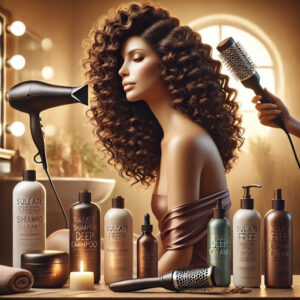Explore the Rich History and Modern Techniques of Perms for Stunning Hairstyles
 The fascinating evolution of perms, widely known as permanent waves, spans millennia and is steeped in cultural significance. This enduring hair treatment can be traced back to ancient societies, particularly in Egypt, where women creatively utilized rudimentary methods to curl their locks. Techniques included wrapping hair around wooden sticks or employing heated metal tools to achieve beautiful waves and curls, which served not only as a fashion statement but also as an expression of cultural identity and social status. As time advanced, the craft of curling hair experienced remarkable changes, especially with the invention of the mechanical curling iron in the 19th century, a groundbreaking advancement that revolutionized hairstyling practices.
The fascinating evolution of perms, widely known as permanent waves, spans millennia and is steeped in cultural significance. This enduring hair treatment can be traced back to ancient societies, particularly in Egypt, where women creatively utilized rudimentary methods to curl their locks. Techniques included wrapping hair around wooden sticks or employing heated metal tools to achieve beautiful waves and curls, which served not only as a fashion statement but also as an expression of cultural identity and social status. As time advanced, the craft of curling hair experienced remarkable changes, especially with the invention of the mechanical curling iron in the 19th century, a groundbreaking advancement that revolutionized hairstyling practices.
The introduction of the mechanical curling iron in the 19th century marked a significant milestone in hair styling technology. This innovative tool allowed individuals to create uniform and long-lasting curls, paving the way for the modern perm. As we transitioned into the 20th century, the perming process underwent a dramatic transformation with the advent of chemical techniques. In the 1930s, a pioneering German hairdresser, Karl Nessler, introduced the first chemical perm method, which employed a unique solution to alter the hair's natural structure. This groundbreaking technique enabled hairstylists to reshape hair into gorgeous curls, quickly gaining popularity in salons throughout Europe and America. Consequently, the perm became an essential component of hairstyling, forever altering the hair fashion landscape.
In the post-war period, perms cemented their role as a staple in women's hairstyling. This era saw the emergence of diverse techniques designed to cater to a wide range of hair types and styling desires. By the vibrant 1980s, perms reached their zenith, characterized by the voluminous curls and waves that epitomized the fashion of the time. However, as the 1990s and early 2000s approached, preferences shifted towards sleek, straight styles, leading to a decline in perm popularity. Today, we are witnessing a remarkable resurgence of interest in perms, with contemporary techniques offering softer, more natural-looking waves that resonate with a new generation eager to explore versatility in their hairstyles.
Essential Insights on the Historical Influence and Progression of Perms
- Perms originated in ancient Egypt, evolving into a notable hair styling method that maintains its relevance today.
- Choosing the appropriate perm for your hair involves considering factors like hair texture, length, and previous chemical treatments to achieve the best results.
- The perming process includes applying a chemical solution that disrupts and reforms the hair's natural bonds, requiring careful preparation, including refraining from washing and using styling products beforehand.
- Maintaining permed hair necessitates special care and styling techniques, such as utilizing sulfate-free products and limiting excessive heat styling to preserve curl integrity.
- Common myths surrounding perms include the belief that they damage hair and the notion that they are only appropriate for specific hair types.
 Effective Techniques for Choosing the Perfect Perm Based on Your Hair Type
Effective Techniques for Choosing the Perfect Perm Based on Your Hair Type
Assessing Your Hair Type: The Foundation for Choosing the Right Perm
Selecting the ideal perm for your hair is a nuanced process that requires a thoughtful assessment of several factors that could impact the final result. Understanding your hair's texture is of utmost importance. For instance, individuals with fine hair may find that a body wave perm is the most beneficial, as it adds just the right amount of volume without overwhelming delicate strands. Conversely, those with thicker hair can confidently choose tighter curls that provide definition and bounciness. This customized approach ensures that the perm not only enhances your hair's natural beauty but also aligns with your individual styling preferences, allowing you to express your personal style more effectively.
Considering Hair Health and Lifestyle Factors When Choosing a Perm
In addition to evaluating texture, it is crucial to assess the overall health of your hair and how well a perm fits into your daily routine. If your hair has been previously damaged or extensively processed, opting for a gentler method may be wise. Choosing a digital or cold perm, which utilizes lower heat and milder chemical solutions, can be beneficial. Consulting with a professional stylist can provide invaluable insights, leading you to a perm that best suits your unique hair characteristics and needs. Furthermore, consider your lifestyle and maintenance preferences; for those with busy schedules, loose waves or beachy curls may present the most suitable low-maintenance option.
Integrating Face Shape and Personal Aesthetic into Your Perm Choice
Another essential consideration is how your chosen perm will enhance your face shape and overall look. For example, soft waves can beautifully frame your face, while tighter curls can add height and volume. By taking these factors into account, you can make an informed decision that not only reflects your personal style but also fits seamlessly into your hair care regimen. Thoughtfully considering these aspects empowers you to select a perm that enhances your features, ultimately aligning with your styling preferences and allowing you to showcase your individuality.
Comprehending the Perming Process: What to Expect and How to Get Ready
Beginning the journey of obtaining a perm can evoke a mix of excitement and apprehension. To ensure a smooth experience, it is critical to understand the steps involved in the process. First and foremost, a consultation with your stylist is indispensable; they will evaluate your hair type and discuss your desired outcome, laying the foundation for the entire perming experience.
Once you and your stylist agree on a specific style, the next step involves thoroughly cleansing your hair with a clarifying shampoo. This crucial step removes any product buildup, ensuring that the perm solution can penetrate effectively. Following this, your hair will be sectioned and wrapped around perm rods according to the desired curl size—smaller rods yield tighter curls, while larger rods create looser waves. After wrapping the hair, the stylist will apply a specialized perm solution that is designed to disrupt the protein structure of your hair, allowing it to take on the shape of the rods.
This stage requires patience, as careful application and monitoring are vital to achieving optimal results. Once the solution has set for a predetermined amount of time, your stylist will rinse your hair thoroughly before applying a neutralizer, which aids in reforming the hair's structure into its new curl pattern. Finally, after rinsing out the neutralizer, you'll be able to admire your fresh curls or waves! While this process may take several hours depending on your hair's length and thickness, the stunning results often justify the wait.
 Essential Maintenance Tips for Upholding the Beauty of Your Permed Hair
Essential Maintenance Tips for Upholding the Beauty of Your Permed Hair
After embracing your stylish new perm, proper care is crucial to maintaining its beauty and longevity. A critical initial step in caring for permed hair is to avoid washing it for at least 48 hours following the perm. This waiting period is essential for allowing the curls to set correctly, ensuring that the chemical bonds formed during the process remain intact and vibrant.
When it’s time to wash your hair, choose sulfate-free shampoos that are specifically formulated for chemically treated hair. These products help retain moisture while minimizing frizz, enabling your beautiful curls to thrive. Additionally, incorporating regular deep conditioning treatments into your hair care routine can significantly enhance the health and manageability of your permed hair, ensuring it remains soft and vibrant.
Styling permed hair requires a different approach compared to styling straight hair. Embrace products designed for curly hair, such as curl creams or mousses, that provide hold without weighing down your curls. To enhance curl definition, scrunch your hair while it's damp, and consider using a diffuser attachment on your blow dryer to add volume without disrupting the curl pattern. Furthermore, it’s advisable to limit the use of excessive heat styling tools, as they can compromise the integrity of your permed hair over time. Whenever possible, allow your hair to air dry or use low heat settings if necessary. By adhering to these maintenance tips and utilizing products designed for curly hair, you can enjoy vibrant, long-lasting curls.
Dispelling Common Myths About Perms
As we explore the realm of perms, we often encounter myths and misconceptions that can obscure a proper understanding of this cherished hair styling option. One widespread myth is that perms are suitable only for specific hair types or lengths; however, this is far from accurate. While it is essential to consider individual hair characteristics when choosing a perm style, advancements in perming techniques have enabled individuals with various hair types—whether straight, wavy, thick, or fine—to achieve stunning curls and waves.
Another prevalent misconception is that perms inherently damage hair. While it is true that chemical processes can affect hair health if not performed correctly or if proper care is neglected afterward, modern formulations have become significantly gentler compared to those used in previous decades. Additionally, some individuals mistakenly believe that once a perm is obtained, the curls are permanent and unchangeable. In reality, perms typically last between three to six months, with longevity dependent on factors such as hair type and maintenance practices.
As your natural hair grows, you will notice that the curls gradually loosen. Moreover, many people wrongly assume that permed hair requires extensive styling every day; however, with the right care and product selection, maintaining permed hair can actually be relatively low-maintenance. By debunking these myths and misconceptions surrounding perms, we empower ourselves to make informed decisions about our hairstyles, free from fear or uncertainty.
 Weighing the Benefits and Drawbacks of Getting a Perm: Is It the Right Choice for You?
Weighing the Benefits and Drawbacks of Getting a Perm: Is It the Right Choice for You?
When contemplating whether to pursue a perm, it is essential to carefully evaluate the advantages and disadvantages. One significant benefit of getting a perm is its versatility; with curls or waves in place, you can enjoy a myriad of styling options without relying on daily heat styling tools, which can be damaging over time. Additionally, perms can add volume and texture to fine or limp hair, creating the fuller appearance that many desire.
For individuals who struggle to curl their straight hair regularly, a perm offers a long-lasting solution that simplifies daily hair routines. However, there are potential downsides to consider before committing to a perm. Given the time-intensive nature of achieving the desired results, the initial cost can be relatively high compared to other hairstyling alternatives.
Moreover, maintaining permed hair necessitates specific products and care routines that may not align with everyone’s lifestyle or budget. It's also important to recognize that while modern perms are gentler than their predecessors, there remains a risk of damage if proper precautions aren’t observed during the process or afterward. Ultimately, determining whether a perm is the right choice involves reflecting on your style preferences, maintenance capabilities, and willingness to embrace changes in your hairstyling routine.
The intricate realm of perms reveals a rich history intertwined with cultural significance and the evolution of beauty standards. As you navigate the process of selecting the ideal perm for your unique hair type and gain an understanding of what to expect during your journey, you equip yourself with the knowledge to enhance your hairstyling experience. By adopting appropriate care techniques after receiving a perm and dispelling common myths associated with this popular treatment, you can confidently assess whether a perm aligns with your style aspirations and lifestyle needs.
Whether you choose to showcase luscious curls or soft waves as a reflection of your identity or relish the opportunity to experiment with various styles over time, perms provide an exciting avenue for self-expression within the ever-evolving landscape of beauty trends.
Your Most Common Questions About Perms, Answered
What is a perm, and how does it work?
A perm, short for permanent wave, is a chemical treatment designed to alter the hair's natural texture, creating curls or waves that can last for an extended duration.
How long can I expect my perm to last?
The longevity of a perm varies based on individual hair type and aftercare practices; generally, it can last anywhere from 2 to 6 months.
What types of perms are available today?
There are numerous types of perms, including body wave, spiral, and digital perms, each producing distinct styles of curls or waves tailored to various preferences.
Can you explain the perming process?
During a perm, the hair is meticulously wrapped around rods, and a chemical solution is applied to break and reform the hair's natural bonds, resulting in the desired curls or waves.
What are the essential aftercare tips for maintaining a perm?
After getting a perm, it is vital to avoid washing the hair for at least 48 hours, use sulfate-free shampoos and conditioners, and minimize heat styling to preserve the integrity of the curls or waves.
Presented By: Perms @ Amitys
The Article: Perms: Your Essential Guide to Gorgeous Curly Hair appeared first on Amitys Hair Salon.
The Article Perms: The Ultimate Guide to Beautiful Curly Hair Was Found On https://limitsofstrategy.com


The exploration of the rich history and evolving techniques of perms is a fascinating subject that not only highlights the aesthetic journey of hairstyling but also underscores the intricate relationship between culture and personal expression. It’s intriguing to consider how hair has served as a canvas for identity throughout history, reflecting societal norms, status, and individual creativity. The ancient Egyptian practices of using rudimentary methods to curl hair exemplify how even early civilizations prioritized appearance, suggesting that the desire for self-expression through hairstyle is an enduring human trait.
You’ve touched on something really compelling about the interplay between hair and identity. It’s fascinating how hairstyling can tell stories that go way beyond just looks. In many cultures, hair has held deep social and symbolic meanings, often representing class, gender roles, or even tribal affiliations.